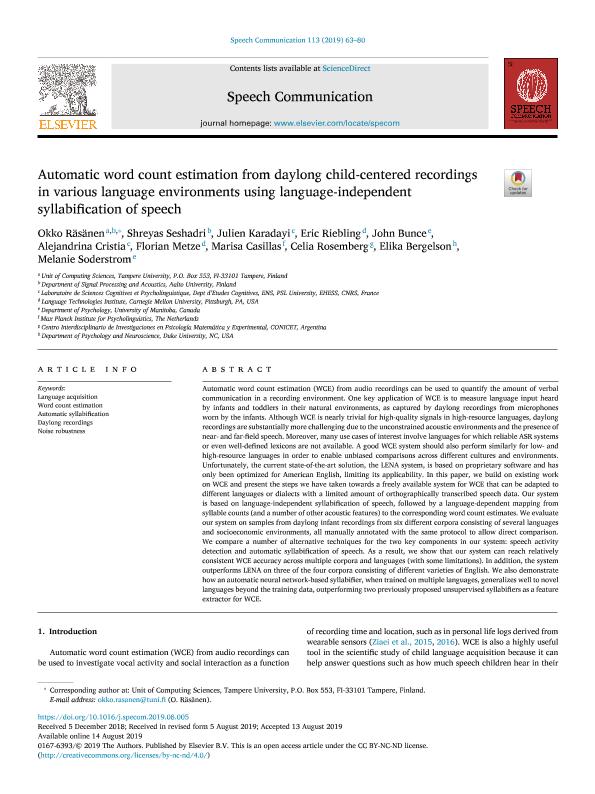Mostrar el registro sencillo del ítem
dc.contributor.author
Räsänen, Okko
dc.contributor.author
Seshadri, Shreyas
dc.contributor.author
Karadayi, Julien
dc.contributor.author
Riebling, Eric
dc.contributor.author
Bunce, John
dc.contributor.author
Cristia, Alejandrina

dc.contributor.author
Metze, Florian
dc.contributor.author
Casillas, Marisa
dc.contributor.author
Rosemberg, Celia Renata

dc.contributor.author
Bergelson, Elika
dc.contributor.author
Soderstrom, Melanie
dc.date.available
2020-06-24T19:53:53Z
dc.date.issued
2019-10
dc.identifier.citation
Räsänen, Okko; Seshadri, Shreyas; Karadayi, Julien; Riebling, Eric; Bunce, John; et al.; Automatic word count estimation from daylong child-centered recordings in various language environments using language-independent syllabification of speech; Elsevier; Speech Communication; 113; 10-2019; 63-80
dc.identifier.issn
0167-6393
dc.identifier.uri
http://hdl.handle.net/11336/108130
dc.description.abstract
Automatic word count estimation (WCE) from audio recordings can be used to quantify the amount of verbal communication in a recording environment. One key application of WCE is to measure language input heard by infants and toddlers in their natural environments, as captured by daylong recordings from microphones worn by the infants. Although WCE is nearly trivial for high-quality signals in high-resource languages, daylong recordings are substantially more challenging due to the unconstrained acoustic environments and the presence of near- and far-field speech. Moreover, many use cases of interest involve languages for which reliable ASR systems or even well-defined lexicons are not available. A good WCE system should also perform similarly for low- and high-resource languages in order to enable unbiased comparisons across different cultures and environments. Unfortunately, the current state-of-the-art solution, the LENA system, is based on proprietary software and has only been optimized for American English, limiting its applicability. In this paper, we build on existing work on WCE and present the steps we have taken towards a freely available system for WCE that can be adapted to different languages or dialects with a limited amount of orthographically transcribed speech data. Our system is based on language-independent syllabification of speech, followed by a language-dependent mapping from syllable counts (and a number of other acoustic features) to the corresponding word count estimates. We evaluate our system on samples from daylong infant recordings from six different corpora consisting of several languages and socioeconomic environments, all manually annotated with the same protocol to allow direct comparison. We compare a number of alternative techniques for the two key components in our system: speech activity detection and automatic syllabification of speech. As a result, we show that our system can reach relatively consistent WCE accuracy across multiple corpora and languages (with some limitations). In addition, the system outperforms LENA on three of the four corpora consisting of different varieties of English. We also demonstrate how an automatic neural network-based syllabifier, when trained on multiple languages, generalizes well to novel languages beyond the training data, outperforming two previously proposed unsupervised syllabifiers as a feature extractor for WCE.
dc.format
application/pdf
dc.language.iso
eng
dc.publisher
Elsevier

dc.rights
info:eu-repo/semantics/openAccess
dc.rights.uri
https://creativecommons.org/licenses/by-nc-nd/2.5/ar/
dc.subject
AUTOMATIC SYLLABIFICATION
dc.subject
DAYLONG RECORDINGS
dc.subject
LANGUAGE ACQUISITION
dc.subject
NOISE ROBUSTNESS
dc.subject
WORD COUNT ESTIMATION
dc.subject.classification
Otras Ciencias de la Educación

dc.subject.classification
Ciencias de la Educación

dc.subject.classification
CIENCIAS SOCIALES

dc.title
Automatic word count estimation from daylong child-centered recordings in various language environments using language-independent syllabification of speech
dc.type
info:eu-repo/semantics/article
dc.type
info:ar-repo/semantics/artículo
dc.type
info:eu-repo/semantics/publishedVersion
dc.date.updated
2020-04-24T17:46:37Z
dc.journal.volume
113
dc.journal.pagination
63-80
dc.journal.pais
Países Bajos

dc.journal.ciudad
Amsterdam
dc.description.fil
Fil: Räsänen, Okko. Universidad de Tampere; Finlandia
dc.description.fil
Fil: Seshadri, Shreyas. Aalto University; Finlandia
dc.description.fil
Fil: Karadayi, Julien. Université Paris Sciences et Lettres; Francia
dc.description.fil
Fil: Riebling, Eric. University of Carnegie Mellon; Estados Unidos
dc.description.fil
Fil: Bunce, John. University of Manitoba; Canadá
dc.description.fil
Fil: Cristia, Alejandrina. Université Paris Sciences et Lettres; Francia
dc.description.fil
Fil: Metze, Florian. University of Carnegie Mellon; Estados Unidos
dc.description.fil
Fil: Casillas, Marisa. Max Planck Institute For Psycholinguistics; Países Bajos
dc.description.fil
Fil: Rosemberg, Celia Renata. Consejo Nacional de Investigaciones Científicas y Técnicas. Oficina de Coordinación Administrativa Saavedra 15. Centro Interdisciplinario de Investigaciones en Psicología Matemática y Experimental Dr. Horacio J. A. Rimoldi; Argentina
dc.description.fil
Fil: Bergelson, Elika. University of Duke; Estados Unidos
dc.description.fil
Fil: Soderstrom, Melanie. University of Manitoba; Canadá
dc.journal.title
Speech Communication

dc.relation.alternativeid
info:eu-repo/semantics/altIdentifier/doi/http://dx.doi.org/10.1016/j.specom.2019.08.005
dc.relation.alternativeid
info:eu-repo/semantics/altIdentifier/url/https://www.sciencedirect.com/science/article/pii/S0167639318304205
Archivos asociados
